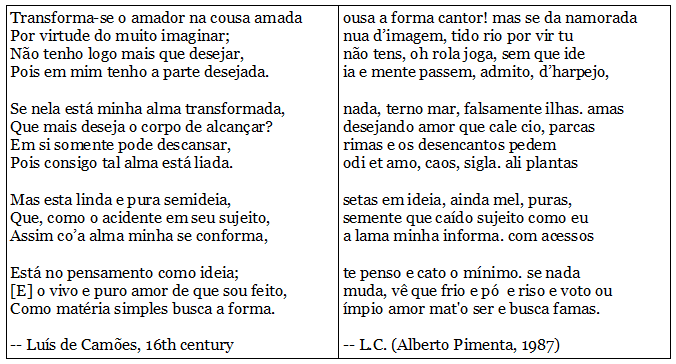
In 1987, Portuguese poet Alberto Pimenta took the sonnet Transforma-se o amador na cousa amada (The lover becomes the thing he loves), by the 16th-century poet Luís de Camões, and rearranged the letters of each line to produce a new sonnet, Ousa a forma cantor! Mas se da namorada (Dare the form, songster! But if the girlfriend).
Here’s Camões’ (curiously apposite) original poem, translated by Richard Zenith:
The lover becomes the thing he loves
by virtue of much imagining;
since what I long for is already in me,
the act of longing should be enough.
If my soul becomes the beloved,
what more can my body long for?
Only in itself will it find peace,
since my body and soul are linked.
But this pure, fair demigoddess,
who with my soul is in accord
like an accident with its subject,
exists in my mind as a mere idea;
the pure and living love I’m made of
seeks, like simple matter, form.
Carlota Simões and Nuno Coelho of the University of Coimbra calculated that the letters in Camões’ sonnet can be rearranged within their lines in 5.3 × 10312 possible ways.
Interestingly, after Pimenta’s anagramming there were two letters left over, L and C, which are the initials of the original poet, Luís de Camões. “It seems that, in some mysterious and magical way, Luís de Camões came to reclaim the authorship of the second poem as well.”
In 2014, when designer Nuno Coelho challenged his multimedia students to render the transformation, Joana Rodrigues offered this:
Related: In 2005 mathematician Mike Keith devised a scheme to generate 268,435,456 Shakespearean sonnets, each a line-by-line anagram of the others. And see Choice and Fiction.
(Carlota Simões and Nuno Coelho, “Camões, Pimenta and the Improbable Sonnet,” Recreational Mathematics Magazine 1:2 [September 2014], 11-19.)
